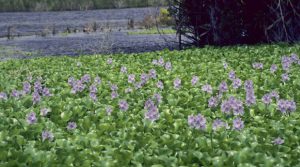A University of Florida scientist is working with a global research team to help control plants, animals and fish before they become invasive. To do this, resource managers first need protocols.
In addition to preserving natural, native fishing habitats, the benchmarks will help businesspeople decide whether to invest in trading or raising certain types of fish.
Aquatic invasive species cost $345 billion annually worldwide, which means investors and taxpayers have a vested interest in the outcomes of such research.
Invasive fish can cause a plethora of problems, including eating native fish and dining on food intended for those same fish. They can also bring diseases to a water body.
Jeff Hill, a UF/IFAS fisheries professor, studies freshwater fish, such as armored catfish, carps and cichlids, but the protocols established by a new study apply to invasive species across the world.
“The trick is to detect their invasive tendencies before they start causing damage,” said Hill, a faculty member at the UF/IFAS Tropical Aquaculture Lab who helped with the newly published study. “We want resource managers to know which species might become invasive so they can help prevent the introduction, establishment and impacts of those species. Through the protocols, we can also help natural resource managers educate the public, and we can help inform invasive species regulation.”

Normally, to control species, most managers prevent the animal, fish or plant from making a home in the ecosystem — what’s called “establishment.” To accomplish this, they look at the results of risk-assessment tools and then use regulations, best management practices (BMPs) and other controls.
BMPs can include infrastructure requirements to reduce the potential for nonnative species to escape.
“That way, people do not suffer economically or in other ways,” Hill said. “A government agency might ban the fish after you’ve set up your business based on what turns out to be an invasive fish.”
To help resource managers, scientists across the globe, including Hill, are fine-tuning a tool called the Aquatic Species Invasiveness Screening Kit, one that predicts potential invasions of aquatic species.
With their new research, which includes the screening kit, they set protocols to detect invasive aquatic species. Fisheries and managers of marine and freshwater habitats can use the benchmarks.
To see if a nonnative species will be invasive, scientists calibrated thresholds for scores, to distinguish non-invasive from invasive species. In the study, scientists also:
- Show managers how to do the statistical procedures for the calibration.
- Recommend how to choose a risk-assessment area.
- Advise managers on how many people making risk assessments should be in a given region and what level of experience they need.
For the study, Hill worked with colleagues in Poland, Croatia and England, including lead scientist Lorenzo Vilizzi at the University of Lodz in Poland and corresponding author Marina Piria of the University of Zagreb in Croatia. Researchers used three invasion risk assessment tools for the study.
“We analyzed our previous research to determine trends and good practices to develop protocols that we hope will help control invasive aquatic species worldwide,” Hill said.
###
ABOUT UF/IFAS
The mission of the University of Florida Institute of Food and Agricultural Sciences (UF/IFAS) is to develop knowledge relevant to agricultural, human and natural resources and to make that knowledge available to sustain and enhance the quality of human life. With more than a dozen research facilities, 67 county Extension offices, and award-winning students and faculty in the UF College of Agricultural and Life Sciences, UF/IFAS brings science-based solutions to the state’s agricultural and natural resources industries, and all Florida residents.
 1
1
